The G6 achieves a certain yin-and-yang. With the GH3 now occupying a higher position in the line, the G6 has moved up to occupy the position once taken by our much loved GH2. It shares the same sensor which of course was always pretty special for video, yet adds a lot of significant new features like 1080/60p, a faster processor, high resolution LCD and something the GH3 doesn’t even have – focus peaking.
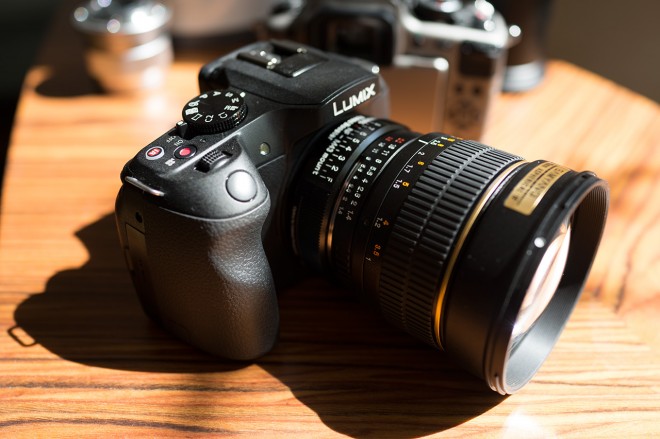
Above: the Panasonic G6 with Metabones Speed Booster for Nikon (Samyang 85mm F1.4 becomes a 60mm F1.0)
The Panasonic G6 is nothing short of a revelation at it’s price point where video is concerned. If you thought the GH2 was good value, consider the extra you get here for $650 (body only). There’s very little practical image quality difference in video mode between the G6 and GH3.
The G6 has an NMOS sensor which if you think in terms of ‘film stocks’, has a different look to CMOS. It is closer in design to a CCD but with the readout speed advantages of a CMOS. The GH3 has a CMOS sensor (rumoured to be supplied by Sony). The G6 has a little bit more aliasing but less moire than the GH3 both issues are barely noticeable on either camera. The GH3 thanks to a higher bitrate codec maintains a slightly finer grain structure but the detail evident on G6 1080p recordings is nothing short of insane. Right up there with the Canon C100.
The G6 is also the cheapest interchangeable lens camera that does 1080/60p to a high standard, something the C100 or C300 do not do. Nearly all Sony NEX cameras have 1080/60p but overall image quality is much cleaner on the G6 making it the best option for slow-mo shooting on a budget.
In short, this is the best 1080/60p you can get for the money.
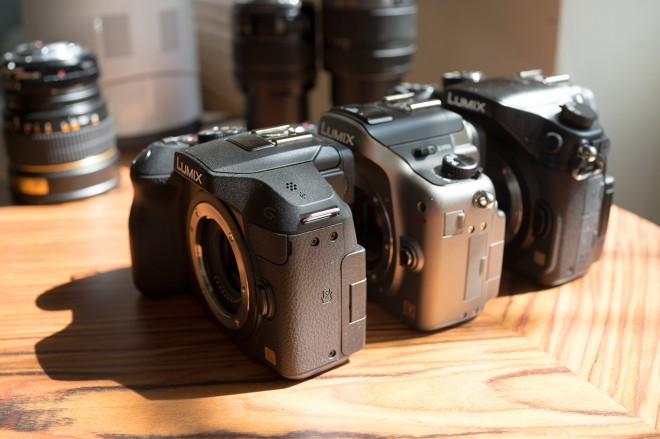
The G6 has a very nice high resolution display which although not as high contrast as the GH3’s display (it isn’t an OLED panel) it doesn’t suffer from the same colour shift at tight viewing angles the GH3’s OLED has.
Surprisingly the viewfinder glass on the G6’s EVF is larger than the GH3’s and doesn’t smear so readily at the edges if your eye isn’t dead square on to it.
The codec is AVCHD for 1080p and AVCHD Lite for 720p with MP4 as another option. MP4 always tends to be a lower quality setting with a low bitrate on Lumix cameras. However 1080/60p in MP4 mode on the G6 maintains the same image quality as the AVCHD setting and the same 28Mbit bitrate (equal to the Sony FS100).
1080/60p in MP4 is compatible with a wider range of editing software than AVCHD without the need to transcode. This mode will get a lot of use from me as I’ve always disliked Quicktime’s handling of AVCHD and the convoluted folder structure. The PAL model does 1080/50p which easily conforms to 25p in post, with the added bonus of slow-mo – not that the G6 lacks 25p for European shooters in AVCHD mode. It also packs 24p. It isn’t a true worldcam (50p is not switchable to 60p) but it is close.
The G6 lacks some of the GH3’s special codec options. There’s no ALL-I codec or 50Mbit / 72Mbit bitrate Quicktime MOV but image quality doesn’t seem to suffer from their omission. Maybe Vitaliy Kiselev will have something to say about the G6 one day – then image quality has a chance of being even better.
Here’s what 1080/24p looks like (in AVCHD mode) on the G6, and a direct comparison with the GH3 in the second half of the video –
[vimeo]http://vimeo.com/70855765[/vimeo]The handling of the camera is ergonomic and feels fluid in the hand. I’ve always liked the GH2’s handling. Panasonic have rounded out the GH2’s angular edges and flattened the top hump considerably which makes it an even more compact body without compromising handling or making it too small to hold properly. It’s also a lot smaller and lighter than the GH3. The G6 moves the mic socket (3.5mm) to the front of the camera and the HDMI port to the right which leaves the left panel behind the articulated screen free of obstructions and your neck free of cables when you’re using the camera on your right shoulder on a video rig. Far from being redundant this panel now has the function of a Near Field Communications area for transfer of files to other smart devices. The G6 also has WiFi like the GH3. All this for $650? Impressive.
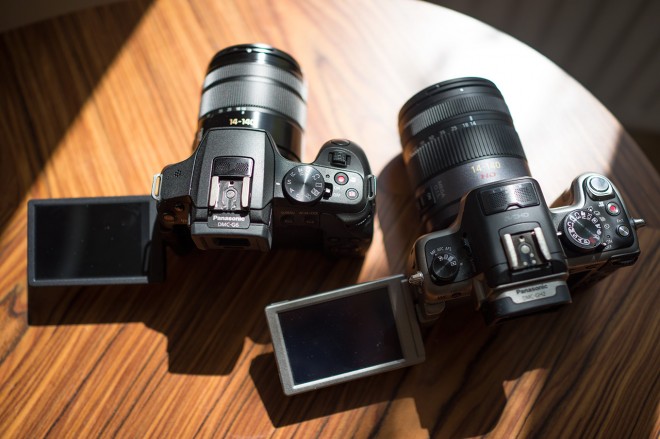
Quirks
Although this latest design is generally very good, some of the ergonomic changes are a little unwelcome. The EVF eyecup is one of the hardest and most uncomfortable I’ve ever used. The GH2 and GH3 have much softer rubberised cups. It’s a basic thing to get right, and the way it is is a bit of an oversight. The card slot has moved under the battery cover on the bottom of the camera, making life more awkward for no good reason. Aside from those quirks it really does feel lovely to use ergonomically. The rear of the camera is pretty much as the GH2 was. The top has a very usable rocker switch which you can customise the function of, and it also acts as a power-zoom rocker for Lumix PZ lenses. The touch screen works well for the odd jab, but I prefer to physical controls for 90% of what I do with the camera.
Though not unexpected for such a low price, the finish of the camera is very plastic. The matte finish of the black body feels a little on the cheap side attracts fine grained dirt. I’m not sure if the white and silver G6 bodies use a higher grade of plastic with a smooth finish. If they do, I’d be tempted to go for those over the black version. The matte finish is grippy but it doesn’t feel very nice to the touch. It could be a similar situation to that of the old GF1 – the black version had a matte finish, but the white version had a very solid feeling resin finish.
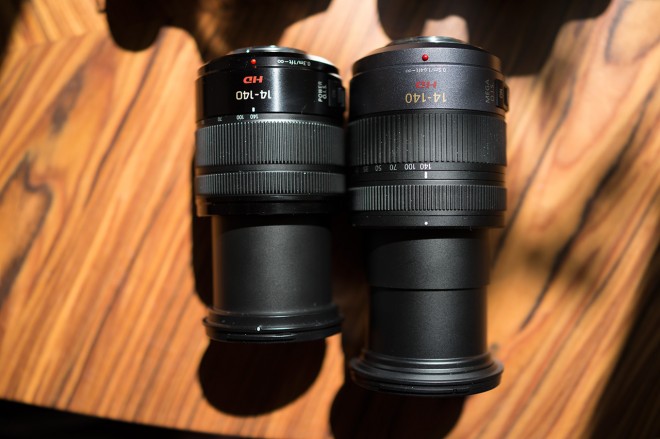
Panasonic have worked hard to get the weight of the camera down to a minimum and they have certain done that. The G6 is incredibly light. The new super zoom kit lens – the 14-140mm F3.5-5.6 Power OIS is also much lighter and smaller than the old version but in removing so much weight Panasonic have made both the lens and camera feel cheaper to the touch and less solid. For example instead of a rubber focus ring grip on the new 14-140mm it is plastic and almost every surface on the camera and lens feels more hollow than before. The camera and lenses are very well built but they don’t feel it quite so much. Therefore if Panasonic would just use less plastic and improve the tactile response of the construction they’d win a lot of new fans. The GH3 partly succeeded in doing this but Lumix bodies still feel cheaper somehow than mid-range Canon and Nikon DSLRs (such as the 6D, 7D and D7100). Way too much plastic! I’d happily pay $200 more per unit for an aluminium housing like the OM-D E-M5. Having said that, this is a $650 body we’re talking about here – the G6 is a lot cheaper than a D7100 so perhaps the D5200 is what it should be compared to.
PS – Much of the mFT 2x crop sensor format is to do with small optics and bodies, but the Sony RX1 shows miniaturisation can be done around a full frame sensor too. Panasonic should look into a new line for the future.
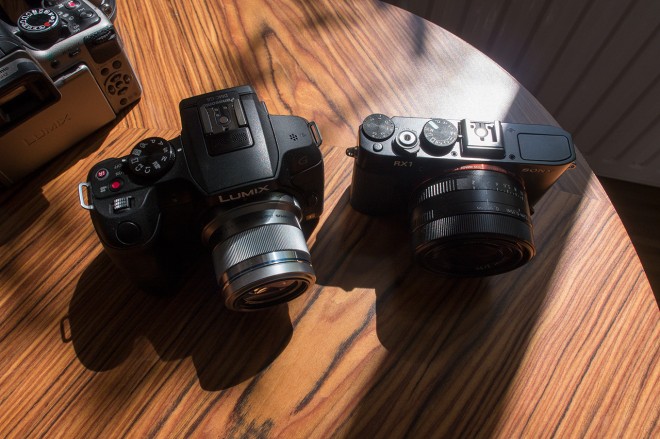
UPDATE 24/07/13
The HDMI jack on this camera is not active in live-view / movie mode, only in playback, meaning the G6 cannot be used with an external monitor or EVF. Do however bear in mind that the live-view monitoring experience on the camera for $650 is well above average. It has a very good built in EVF and a very high resolution articulated screen with peaking and zebra. As a result you need an external device less with the G6 than you would on many other less video optimised DSLRs. There’s no headphone jack for audio monitoring either but the camera has live audio meters, which can be displayed on both the EVF and the live-view display.
Conclusion
When you consider the all-round package, the Panasonic G6 is the best mid-range interchangeable lens camera for video available. Image quality for video is unmatched for the price, although the Nikon D5200 is better in low light the G6 offers way more features and 1080/60p into the bargain. It also offers insane levels of detail at 1080p which the D5200 simply cannot match (sharpening in post or not). It has less moire and aliasing than the Canon 50D in raw or any APS-C Canon DSLR for that matter… Or a Sony NEX! Yet it offers 1080/60p into the bargain.
Below: from left to right – G6, GH2 and GH3
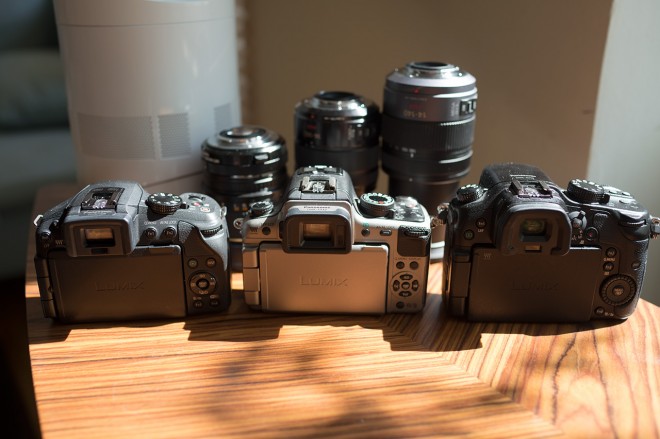
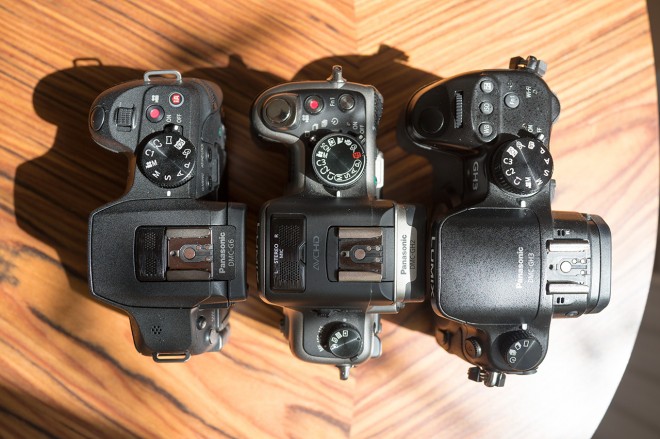
Unless shooting raw on the Canon 50D with Magic Lantern excites you creatively, 90% of shooters may find themselves happier with the practical G6. It’s fun to use and improves upon the already very highly rated GH2. You can grab shots with upmost convenience and speed in the field, so it’s great for documentary style shooters such as myself. Even simple things like an upgraded screen over the GH2. THE worst thing about the 5D Mark III for me is the way the lack of articulated screen kills my back in situations where you don’t want to use a bulky external HDMI monitor. The G6 is certainly a nicer camera to have for travelling or on sticks in front of you. Light, convenient and doesn’t need a ton of add-ons.
Although it doesn’t match the stills and raw video quality coming from the Canon 5D Mark III (nor is it full frame) for $650 you can’t expect it too – yet the G6 gives generously and it has put a smile on my face. The GH2 is back! And for $650 it is better than ever.
Pros
- Huge amount of of features for the money – a supercharged GH2!
- Insane resolution and detail at 1080p
- 1080/50/60p great for slow mo, just as detailed as 24p
- Very versatile lens mount (Speed Booster a bonus) and great choice of native MFT glass
- Some improvements even trump the flagship GH3 –
- Focus peaking (a first on a Lumix body) with single press toggle (not buried in menu)
- A little less moire in video mode
- Better EVF optics, less edge smearing
- Magnified focus assist quicker to move around the frame
- More responsive video start / stop button
- Screen has no colour shift at tight angles
- Faster burst rate (40fps to 20fps)
- Single-piece lug strap joints don’t rattle, don’t need to be removed
- Extremely lightweight and compact body
- Small and light lenses especially the new version Lumix 14-140mm and updated 20mm F1.7 pancake
- No real world moire & aliasing problems
- Straight forward ergonomics and control layout
- Great quality LCD and EVF (better in some ways than higher spec GH3)
- Very fast AF for stills and video alike
- Power zoom rocker switch good for run & gunners
- No cabling or outputs obstruct articulated screen
- Above average onboard mic quality
- 19-step manual gain control, 3.5m mic socket and onscreen audio meters
- Responsive touchscreen with handy drag & drop customisation of the Quick Menu
- Extensive silent control on the touch screen, for aperture, ISO, shutter, audio and even power zoom
- Wifi and NFC
Cons
- No live HDMI feed
- No headphone jack for audio monitoring
- SD card slot behind battery door under camera
- Hard and uncomfortable EVF eyecup
- Matte finish of the body feels a bit cheap and attracts too much dirt
- Power OIS falls short of Olympus IBIS on video stabilisation duties
- Wider FOV in 3:2 and 16:9 of multi-aspect ratio GH2 sensor not utilised by new image processor
- Same exposure switch between live-view and record-mode as GH2
- Somewhat redundant main menu thumbnails page


